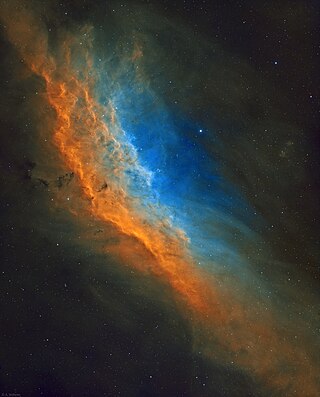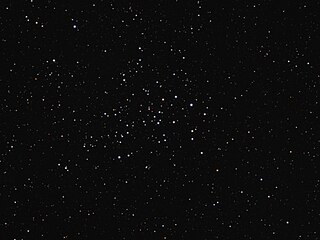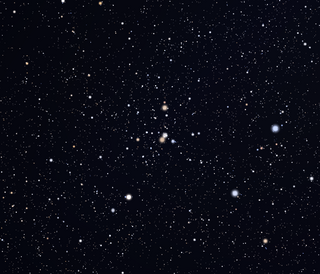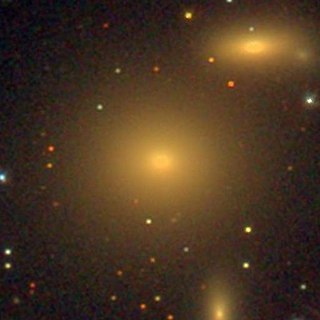
Perseus is a constellation in the northern sky, named after the Greek mythological hero Perseus. It is one of the 48 ancient constellations listed by the 2nd-century astronomer Ptolemy, and among the 88 modern constellations defined by the International Astronomical Union (IAU). It is located near several other constellations named after ancient Greek legends surrounding Perseus, including Andromeda to the west and Cassiopeia to the north. Perseus is also bordered by Aries and Taurus to the south, Auriga to the east, Camelopardalis to the north, and Triangulum to the west. Some star atlases during the early 19th century also depicted Perseus holding the disembodied head of Medusa, whose asterism was named together as Perseus et Caput Medusae; however, this never came into popular usage.

NGC 281, IC 11 or Sh2-184 is a bright emission nebula and part of an H II region in the northern constellation of Cassiopeia and is part of the Milky Way's Perseus Spiral Arm. This 20×30 arcmin sized nebulosity is also associated with open cluster IC 1590, several Bok globules and the multiple star, B 1. It collectively forms Sh2-184, spanning over a larger area of 40 arcmin. A recent distance from radio parallaxes of water masers at 22 GHz made during 2014 is estimated it lies 2.82±0.20 kpc. from us. Colloquially, NGC 281 is also known as the Pacman Nebula for its resemblance to the video game character.

Alpha Persei, formally named Mirfak, is the brightest star in the northern constellation of Perseus, outshining the constellation's best-known star, Algol. Alpha Persei has an apparent visual magnitude of 1.8, and is a circumpolar star when viewed from mid-northern latitudes.

The California Nebula is an emission nebula located in the constellation Perseus. Its name comes from its resemblance to the outline of the US State of California in long exposure photographs. It is almost 2.5° long on the sky and, because of its very low surface brightness, it is extremely difficult to observe visually. It can be observed with a Hα filter or Hβ filter in a rich-field telescope under dark skies. It lies at a distance of about 1,000 light years from Earth. Its fluorescence is due to excitation of the Hβ line in the nebula by the nearby prodigiously energetic O7 star, Xi Persei.

NGC 663 is a young open cluster in the constellation of Cassiopeia. It has an estimated 400 stars and spans about a quarter of a degree across the sky. It can reportedly be detected with the unaided eye, although a telescope is recommended for best viewing. The brightest members of the cluster can be viewed with binoculars. Although the listed visual magnitude is 7.1, several observers have reported higher estimates.

NGC 869 is an open cluster located 7460 light years away in the constellation of Perseus. The cluster is about 14 million years old. It is the westernmost of the Double Cluster with NGC 884.

NGC 884 is an open cluster located 7640 light years away in the constellation of Perseus. It is the easternmost of the Double Cluster with NGC 869. NGC 869 and 884 are often designated h and χ Persei, respectively. The cluster is about 14 million years old. Located in the Perseus OB1 association, both clusters are located physically close to one another, only a few hundred light years apart. The clusters were first recorded by Hipparchus, thus have been known since antiquity.

The Double Cluster consists of the open clusters NGC 869 and NGC 884, which are close together in the constellation Perseus. Both visible with the naked eye, NGC 869 and NGC 884 lie at a distance of about 7,500 light years in the Perseus Arm of the Milky Way galaxy.

The Alpha Persei Cluster, also known as Melotte 20 or Collinder 39, is an open cluster of stars in the northern constellation of Perseus. To the naked eye, the cluster consists of several blue-hued spectral type B stars. The most luminous member is the ~2nd magnitude white-yellow supergiant Mirfak, also known as Alpha Persei. Bright members also include Delta, Sigma, Psi, 29, 30, 34, and 48 Persei. The Hipparcos satellite and infrared color-magnitude diagram fitting have been used to establish a distance to the cluster of ~560 light-years (172 pc). The distance established via the independent analyses agree, thereby making the cluster an important rung on the cosmic distance ladder. As seen from the Earth, the extinction of the cluster due to interstellar dust is around 0.30.

S Persei is a red supergiant or hypergiant located near the Double Cluster in Perseus, north of the cluster NGC 869. It is a member of the Perseus OB1 association and one of the largest known stars. If placed in the Solar System, its photosphere would engulf the orbit of Jupiter. It is also a semiregular variable, a star whose variations are less regular than those of Mira variables.

NGC 637 is an open cluster of stars in the northern constellation of Cassiopeia, positioned about 1.5° to the WNW of the star Epsilon Cassiopeiae. The cluster was discovered on 9 November 1787 by German-born English astronomer William Herschel. It is located in the Perseus Arm of the Milky Way, at a distance of approximately 7.045 kilolight-years from the Sun. The cluster is small but compact, and is readily visible in a small telescope.

RS Persei is a red supergiant variable star located in the Double Cluster in Perseus. The star's apparent magnitude varies from 7.82 to 10.0, meaning it is never visible to the naked eye.

T Persei is a red supergiant located in the constellation Perseus. It varies in brightness between magnitudes 8.3 and 9.7 and is considered to be a member of the Double Cluster.

NGC 1342 is an open cluster in the constellation Perseus. It was discovered by William Herschel on 28 December 1799. It is located in the south of the constellation, almost halfway between Algol and ζ Persei, away from the plane of the Milky Way. NGC 1342 has an apparent size of 17' and an apparent magnitude of 6.7, marginally visible by naked eye. In 1994, Peña, J. H. and Peniche, R. estimated by the use of photometric data, that the age of the cluster is 400 million years.

NGC 1528 is an open cluster in the constellation Perseus. It was discovered by William Herschel in 1790. It is located in the north-eastern part of the constellation, just under 3 degrees north of μ Persei. Less than 1.5° to the southeast is the open cluster NGC 1545. The NGC 1528 is clearly visible with 10x50 binoculars. 165 stars are recognised as members of NGC 1528, the brightest of which has apparent magnitude 8.7.

NGC 1545 is an open cluster in the constellation Perseus. It was discovered by William Herschel on December 28, 1790. It is located in the north-eastern part of the constellation, a few arcminutes east of the 4.5 magnitude star b Persei, near the equally large and bright NGC 1528, which is less than 1.5° towards the northwest. However, it is less dense and rich. The brightest star of the cluster is a K5 III giant star, with 7.1 magnitude, but its membership is questionable. One more 7.9 magnitude star is visible at the north edge of the cluster.

NGC 1245 is an open cluster in the constellation Perseus. It was discovered by William Herschel in 11 December 1786. It is located 3° southwest of alpha Persei and can be spotted with 10x50 binoculars. The cluster is nearly 1 billion years old. NGC 1245 has about 200 members the brightest of which are of 12th magnitude. The cluster shows evidence of mass segregation and it is possible that it has lost its lower mass members. Lying at a distance of 3kpc, the cluster is estimated to be 27 light years across.

V520 Persei is a blue supergiant member of NGC 869, one of the Perseus Double Cluster open clusters. It is an irregular variable star. At a magnitude of 6.55, V520 Persei is the brightest member in either NGC 869 or NGC 884, although the brighter HD 13994 lies in the foreground along the same line of sight.

NGC 1278 is an elliptical galaxy located about 230 million light-years away in the constellation Perseus. NGC 1278 was discovered by astronomer Heinrich d'Arrest on February 14, 1863. It was then rediscovered by astronomer Guillaume Bigourdan on October 22, 1884 and was later listed as IC 1907. NGC 1278 is a member of the Perseus Cluster and is a low-luminosity AGN (LLAGN).

NGC 1444 is a small open cluster of stars in the northern constellation of Perseus, about 2-1⁄4° to the northwest of 43 Persei. It has an angular diameter of 4 arcminutes and a brightness of 6.60 in visual magnitude. The cluster has sixty members of seventh magnitude or fainter, and is better appreciated in larger telescopes. NGC 1444 was discovered on 18 December 1788 by the German-British astronomer William Herschel. It is located at a distance of 4,200 light-years from the Sun and is about 7.1 million years old. The cluster has a physical core radius of 1.73 ± 0.42 ly and a tidal radius of 17.4 ± 4.2 ly. The most prominent member is the triple star system Σ446, with a magnitude 6.7 primary. The cluster is a member of the Camelopardalis OB1 association.


















